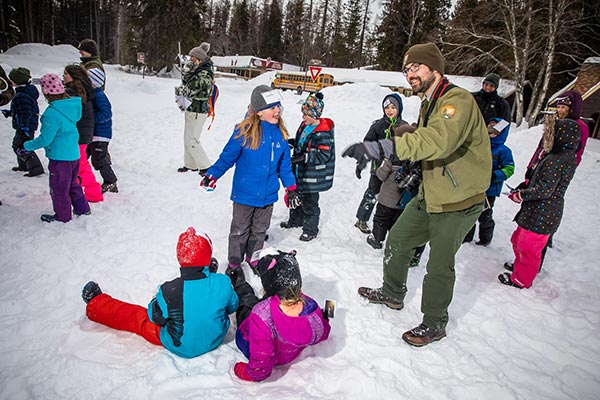Last updated: December 29, 2020
Lesson Plan
Dressing for Winter

- Grade Level:
- Lower Elementary: Pre-Kindergarten through Second Grade
- Subject:
- Science,Social Studies
- Lesson Duration:
- 60 Minutes
- Common Core Standards:
- K.SL.1, 1.SL.1, 2.SL.1
Essential Question
What are some ways that we know it is winter? What are some ways that people and animals are alike in how they deal with winter?
Objective
Students will be able to choose appropriate clothing for winter activities. Students will explain what the three clothing layers should be for outdoor winter activities and why each layer is needed.
Background
Just like the animals in Glacier, people must prepare their bodies to be outside in the winter. Some animals prepare by adding a layer of insulating fat to their bodies. Others grow a thick winter coat to trap their body heat close to their skin to keep them warm. Since people can’t easily insulate our bodies with seasonal fat or fur, we must use clothing to keep us warm and safe. The first rule of dressing for winter is layering. Layering clothing keeps moisture away from skin, creates insulation to keep the body warm, and protects against the “elements” - wind, snow, rain.
Outer layers should repel water and stop the wind to protect the wearer from convection heat loss and allow ventilation to minimize evaporative heat loss. Middle layers should insulate the body. They should also “breathe” easily. Inner layers of clothing should be of materials that “wick” moisture away from the skin. Finally, all layers of clothing should dry rapidly, preferably from body heat alone (i.e. cotton is not a great choice for winter clothing. It absorbs water into its fibers and stays wet for a long time).
Gloves and mittens protect hands from being cold while a pair of wool socks or polypropylene will keep feet warm even if they get wet.
Preparation
- Warm clothing (ex: base layer/long underwear, fleece, coat, snow pants, shirt/pants, socks, etc.).
- Print student templates, attached under Lesson Materials.
Materials
Procedure
- Discuss with students some ways wild animals stay warm in winter. For example, most mammals (bears, white-tailed deer, beavers, etc.) use fat to stay warm. Their fur also grows thicker and/or longer to insulate the animal’s body.
- Show students the winter-dressed student on an interactive whiteboard or document camera. Because people can’t use seasonal fat or grow a fur coat, people rely on clothing to stay warm. Discuss the things everyone should remember to bring to be safe and warm while snowshoeing in Glacier (hat, coat, mittens, etc.).
- Explain to students that you will show them how to dress for outdoor winter activities. Knowing how to dress for winter weather is the first step to having a great time outdoors and being safe.
- Select a student to be the model. Over their regular clothes, prepare the model for a day snowshoeing in Glacier.
- Start with base layers, like long underwear. Discuss how the special material of these kinds of clothing helps to keep the body warm and takes moisture away from the body.
- Add middle layers. These could include athletic pants, a wool sweater, a fleece layer, etc.
- Put on the outer layer. Discuss how winter coats and snow pants are made of special material to keep the body dry, even when it’s raining or snowing.
- Don’t forget gloves or mittens, hats, and boots.
- Mention that dressing in layers allows you to add or subtract layers of clothing depending on the weather and temperatures.
- Another option is to bring in a backpack or bag with the clothing in it and have different students come up and pull out an article and decide if they are appropriate - make sure to include cotton jeans, a baseball cap, a goofy T-shirt, and perhaps some other article that students will chuckle about.
Extension
Have students think about how animals “get dressed” for winter.
Can students think of other things, besides clothes, that could keep them warm outside in the winter? (Drink hot chocolate, build a fire, exercise, etc.)
Vocabulary
Insulation
Assessment Materials
Have students draw themselves all ready for a field trip snowshoeing in Glacier, making sure they are bringing all of the necessary items. Use the template on page 8. Older students can list and describe each clothing layer and its function.
